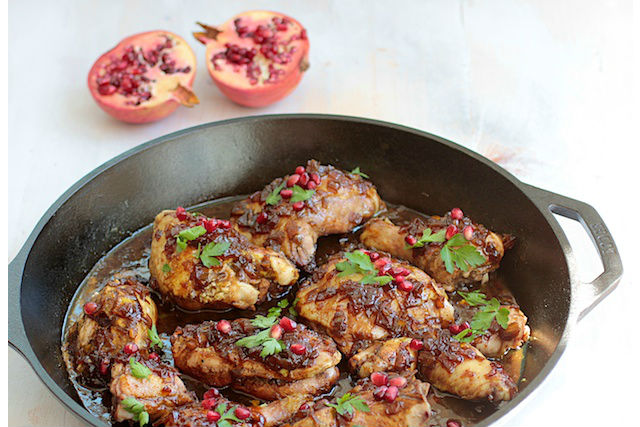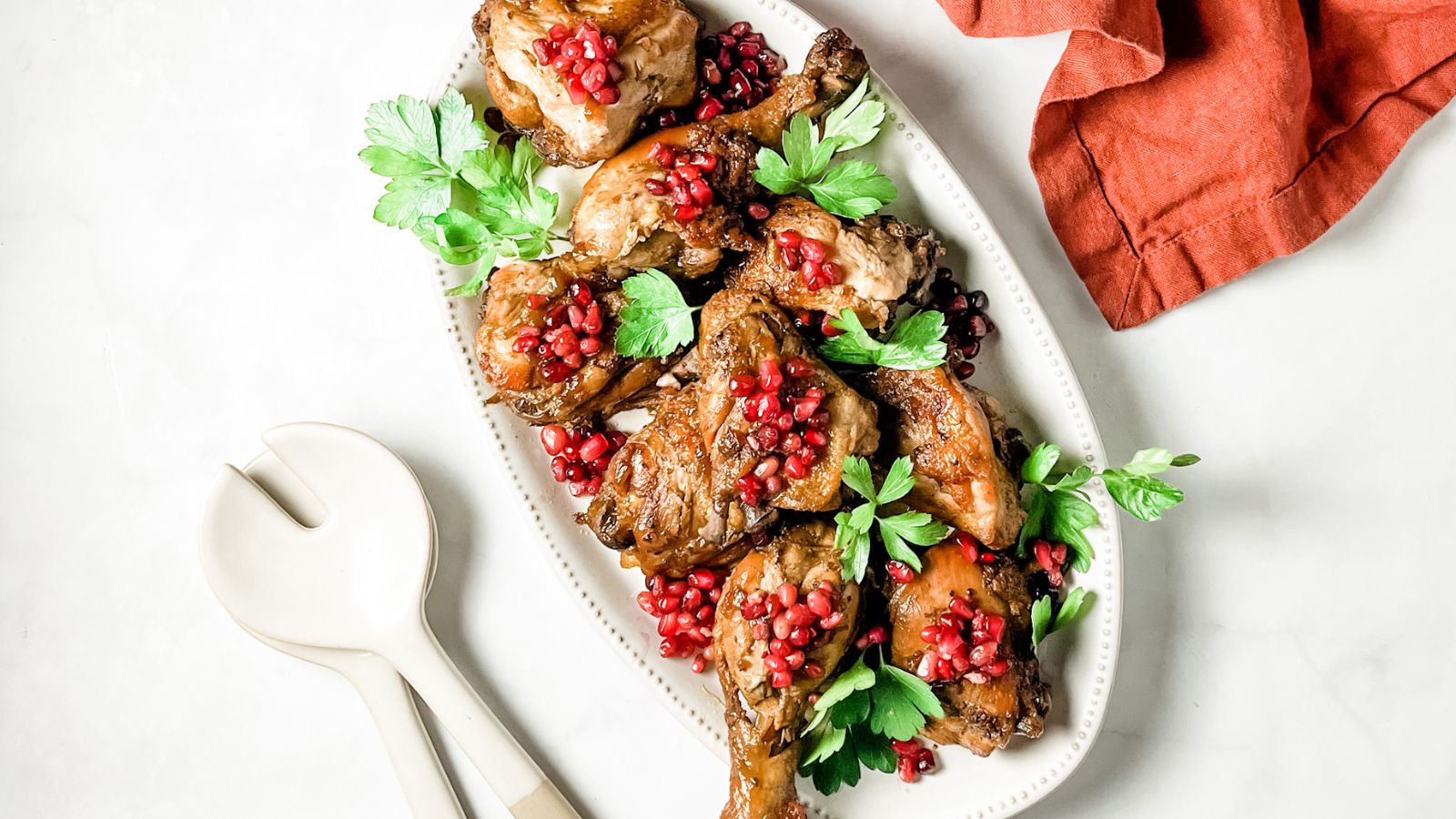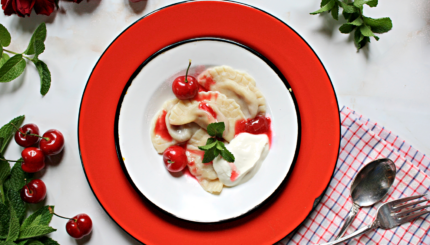Pomegranates, or “rimonim” in Hebrew, are one of the most recognizable and highly symbolic fruits in Jewish culture. Originating in Persia, these reddish, thick skinned fruit (technically a berry) begin to appear in markets at end of summer and are readily available for holiday cooking by Rosh Hashanah.
According to Gil Marks in “The Encyclopedia of Jewish Food,” the abundance of seeds, nestled into a white membrane and encased in a protective and leathery skin, is associated with the 613 commandments in the Torah. They serve as symbols of righteousness and fruitfulness as expressed in the expression, “May we be full of merits like the pomegranate (is full of seeds).”
This ancient fruit, prized for its juice and seeds (called arils) is mentioned in the Bible as one the seven most bountiful agriculture products of ancient Israel. It is associated with fertility and sensuality and is mentioned six times in the “Song of Songs.”
In biblical times, pomegranates were used to add tart flavors to ancient dishes before lemons and tomatoes were discovered. Since then, pomegranates have been used to add unique and complex dimensions to and central Asian soups, stews, sauces, chutneys and desserts. They may be juiced, dried, reduced, ground or pressed into pomegranate oil.
The Nosher celebrates the traditions and recipes that have brought Jews together for centuries. Donate today to keep The Nosher's stories and recipes accessible to all.
Today, pomegranates are prized for their antioxidant and potent nutritional value, just as they were in ancient Egypt when the seeds were believed to heal intestinal disorders. Juice, molasses (actually a reduction and thickening of the juice and sometimes called pomegranate concentrate or syrup) and arils are used in a wide range of applications including cocktails, glazes, simmer sauces, and glistening toppings for green salads and vegetable dishes.
In “The New Persian Kitchen,” author Louisa Shafia offers numerous pomegranate dishes including a classic Iranian stew called fesenjan, often served at celebrations. The chicken is cooked with beets and thickened with coarsely ground walnuts and pomegranate molasses. As in many Persian dishes, pomegranate seeds are used as a glistening, jewel-like garnish.
She illustrates removing the seeds a few different ways but I like the “water method” best. Simply slice off the two ends and quarter the fruit with a knife. Submerge the quarters in a bowl of cold water and pull out the seeds with your fingers. The pith and skin float to the surface as the arils sink to the bottom. Scoop out everything but the seeds and pour water and seeds through a mesh colander to collect them.
Consider using pomegranates in your Rosh Hashanah meals when it is considered a positive omen, or segulah, to incorporate symbolic foods in our holiday menus. Whip up this easy chicken dish and you’ll have both bountiful and sweet symbols covered.
Holiday chicken is potent with pomegranates goodness as this symbolic fruit is used in three ways: juice, molasses and arils (seeds). The flavors are bold, tangy and slightly sweet — a Middle Eastern influenced sweet and sour!
Pomegranates are highly symbolic in Jewish tradition, most often associated with fertility and good deeds. By combining the tart flavors of pomegranates with honey here, the sweetness balances the tang and positive energy is imbued in this main course for Rosh Hashanah.
Note: The simmered sauce may be prepared 2-3 days ahead and refrigerated until ready to prepare the chicken.

Pomegranate and Honey Glazed Chicken
A chicken recipe full of flavor and symbolism!
- Total Time: 1 hour 20 minutes
- Yield: 4
Ingredients
For the chicken:
- 1 (4 lb) chicken cut in ⅛ths (breasts cut in half if large)
- 4 Tbsp canola oil (separated: 2 Tbsp for simmer sauce and 2 Tbsp for browning the chicken)
- 1 large onion, chopped
- 3 cloves garlic, minced
- ½ cup pomegranate molasses
- ½ cup sweetened pomegranate juice
- ½ cup honey
- 2 cups vegetable or chicken broth
- 1 tsp cumin
- ½ tsp powdered ginger
- ⅛ tsp allspice
- ½ tsp turmeric
- salt and pepper to taste
For the garnish:
- 2 Tbsp parsley
- 2 Tbsp pomegranate arils (seeds)
Instructions
- Heat 2 Tbsp canola oil in a large pan (you’ll need a lid for later).
- Sauté chopped onion until soft and translucent. Add minced garlic and saute for 2-3 minutes (do not brown). Add pomegranate molasses, juice, honey, broth and spices. Stir and bring to boil.
- Reduce to an active simmer, and cook uncovered, for about 20 minutes or until sauce is reduced by about ½ the volume and slightly thickened. Taste sauce and adjust seasoning. Too tart? Add 1-2 Tbsp honey. Want more kick? Crack more black pepper.
- Remove sauce from heat and pour into bowl. Set aside. Wash pan.
- Rinse chicken parts, pat dry, season with salt and pepper. Heat remaining 2 Tbsp oil in pan and place chicken parts skin side down.
- Brown on one side and flip to second side. Do not crowd chicken in the pan as this causes chicken to steam rather than brown. Lower heat, pour prepared simmer sauce over the chicken.
- Cover pan and simmer on low for 35-40 minutes.
- Remove from pan and platter, garnishing with chopped parsley and pomegranate arils.
- Prep Time: 20 minutes
- Cook Time: 60 minutes
- Category: Dinner
- Method: Stovetop
- Cuisine: High Holidays




Can this be baked in the oven?
I have this question too
Looks delicious. I am going to try when I get better.
Delicious
Sounds amazing! Can I freeze the chicken with the sauce?
I’m unable to find pomegranate molasses What is a good subtitude.
You can actually make your own pomegranate molasses by reducing down pomegranate juice.
how do you make the pomegranate molasses? I can not find it in our supermarket.
Hi Laurie, you can make your own pomegranate molasses by reducing down pomegranate juice until it thickens into a maple syrup-like consistency. Rachel at The Nosher.
Can I prepare this dish in advance?
Absolutely.
if you cook it the night before, how do you reheat it?
Hi Ida, the recipe says you can make the sauce ahead, but doesn’t detail the chicken. That said, if you turn off the heat as soon as the chicken is cooked through (so closer to 35 minutes), you could reheat the dish over medium-low heat on the stove the following day, and garnish before serving.
This sounds delicious. Can it be cooked in the oven after the chicken is browned?
Thanks, Jessica — it is!) We haven’t tested this recipe in the oven, but you could try cooking it, covered, in a low oven during Direction 7. As on the stovetop, you’re looking for the sauce to be at a simmer (gently bubbling). I’d check the chicken around 30 minutes to see if it’s cooked through. Let us know how it turns out! Rachel at The Nosher.
did you end up trying the oven?
This recipe is wonderful!! I did made a few modifications…I prepared it on a large cast iron skillet, so I was able to put it in a hot 400°F oven for about 10 minutes after cooking covered on the stove to brown and crisp the chicken skin. Then I thickened the sauce further by adding a bit of flour so it made a heartier sauce. It was unbelievable!! This is a keeper, even after the holidays! Thanks so much.
This was great. I would recommend reducing and maybe thickening the final sauce.
how did you thicken the sauce? did you do it on stove top or oven